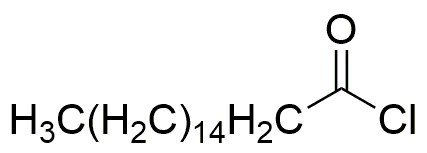Heptadecanoyl chloride is widely utilized in research focused on:
- Synthesis of Fatty Acid Derivatives: This compound serves as a key reagent in the synthesis of various fatty acid derivatives, which are important in the production of surfactants and emulsifiers used in cosmetics and personal care products.
- Pharmaceutical Applications: It is used in the development of pharmaceutical compounds, particularly in the synthesis of lipid-based drug delivery systems that enhance the bioavailability of poorly soluble drugs.
- Polymer Chemistry: Heptadecanoyl chloride is employed in the preparation of polyamide and polyester materials, which are utilized in textiles and packaging, offering improved durability and performance.
- Bioconjugation Techniques: This chemical is valuable in bioconjugation processes, allowing researchers to attach biomolecules to surfaces or other molecules, which is crucial for developing biosensors and diagnostic tools.
- Research in Lipid Chemistry: It plays a significant role in lipid chemistry research, helping scientists understand lipid metabolism and its implications in health and disease, which can lead to advancements in nutritional science and therapeutic strategies.
Información general
Propiedades
Seguridad y normativas
Aplicaciones
Heptadecanoyl chloride is widely utilized in research focused on:
- Synthesis of Fatty Acid Derivatives: This compound serves as a key reagent in the synthesis of various fatty acid derivatives, which are important in the production of surfactants and emulsifiers used in cosmetics and personal care products.
- Pharmaceutical Applications: It is used in the development of pharmaceutical compounds, particularly in the synthesis of lipid-based drug delivery systems that enhance the bioavailability of poorly soluble drugs.
- Polymer Chemistry: Heptadecanoyl chloride is employed in the preparation of polyamide and polyester materials, which are utilized in textiles and packaging, offering improved durability and performance.
- Bioconjugation Techniques: This chemical is valuable in bioconjugation processes, allowing researchers to attach biomolecules to surfaces or other molecules, which is crucial for developing biosensors and diagnostic tools.
- Research in Lipid Chemistry: It plays a significant role in lipid chemistry research, helping scientists understand lipid metabolism and its implications in health and disease, which can lead to advancements in nutritional science and therapeutic strategies.
Documentos
Hojas de datos de seguridad (HDS)
La SDS proporciona información de seguridad completa sobre la manipulación, el almacenamiento y la eliminación del producto.
Especificación del producto (PS)
La PS proporciona un desglose completo de las propiedades del producto, incluida la composición química, el estado físico, la pureza y los requisitos de almacenamiento. También detalla los rangos de calidad aceptables y las aplicaciones previstas del producto.
Certificados de análisis (COA)
Busque certificados de análisis (COA) ingresando el número de lote del producto. Los números de lote y de partida se pueden encontrar en la etiqueta de un producto después de las palabras "Lote" o "Lote".
Número de catálogo
Número de lote/lote
Certificados de origen (COO)
Este certificado de origen confirma el país en el que se fabricó el producto y también detalla los materiales y componentes utilizados en él y si se deriva de fuentes naturales, sintéticas u otras fuentes específicas. Este certificado puede ser necesario para cumplir con las normativas aduaneras, comerciales y regulatorias.
Número de catálogo
Número de lote/lote
Hojas de datos de seguridad (HDS)
La SDS proporciona información de seguridad completa sobre la manipulación, el almacenamiento y la eliminación del producto.
DownloadEspecificación del producto (PS)
La PS proporciona un desglose completo de las propiedades del producto, incluida la composición química, el estado físico, la pureza y los requisitos de almacenamiento. También detalla los rangos de calidad aceptables y las aplicaciones previstas del producto.
DownloadCertificados de análisis (COA)
Busque certificados de análisis (COA) ingresando el número de lote del producto. Los números de lote y de partida se pueden encontrar en la etiqueta de un producto después de las palabras "Lote" o "Lote".
Número de catálogo
Número de lote/lote
Certificados de origen (COO)
Este certificado de origen confirma el país en el que se fabricó el producto y también detalla los materiales y componentes utilizados en él y si se deriva de fuentes naturales, sintéticas u otras fuentes específicas. Este certificado puede ser necesario para cumplir con las normativas aduaneras, comerciales y regulatorias.

